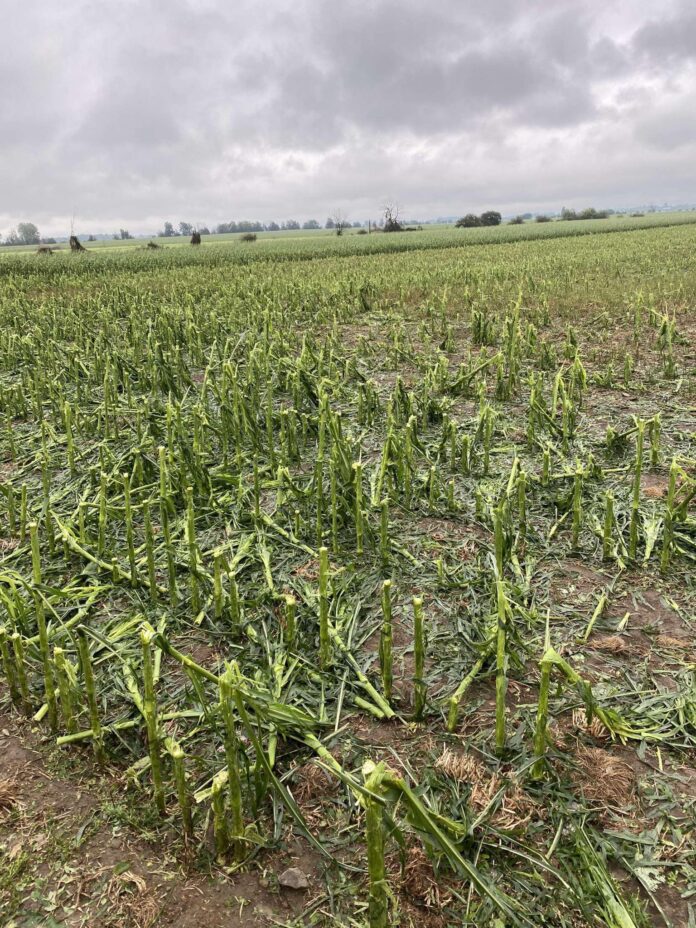by Hayley Bedford
On the morning of July 20, local farmer Joe Spruit was taking a walk through one of his soy bean fields on Spruit Road. He was inspecting the crop for aphids. The crop was doing well and was at least thigh height. While the beans were housing a few unwanted lodgers, Joe decided he would let nature take its course and trusted the ladybugs to take care of them for him.
Unfortunately, by supper time that night, there were no crops left for the insects to fight over.
At around 3pm that day, one of the most violent storms North Dundas has ever witnessed ripped through our township and left a trail of absolute crop devastation in its wake. “I have lived here my entire life, and have never seen anything like that, not with the hail”, said Joe.
While the weather all around the area was terrible, the eye of the storm seemed to land on the high point of Kerr’s Ridge Road in Hallville. The farms at that particular point were victims of golf ball-sized hail that damaged vehicles and farm equipment, as well as punching holes in the house sidings as though they were paper.
North Dundas Councillor Tyler Hoy’s farm was one of the worst hit. Mr Hoy told the Times: “We have lost around 800 acres of corn and bean. We also had to replace the siding on two buildings and suffered damage to our vehicles and an auger. I have never known a storm do so much damage to such a large area in one hit.” Another farmer further down the same road also lost the roof off his barn!
As the storm continued in a south easterly direction, more farms along Spruit Road, Riddell Road, and County Roads 31 and 43 were damaged in its path. Winds of 100 kmph and bullet like hail left corn crops snapped and shredded, while all that remained of some bean fields was stripped stalks. The Spruit Farm lost 430 acres of soy bean from the 900 that were planted.
The hail wasn’t the only damaging factor. Lightning strikes were also wreaking havoc with digital farming equipment. Hayley from Cookes Scales said, “There has been significant damage to scales from lightning to some businesses in the area. Scales often have lightning protection; but when it’s a direct, or very close hit, the circuitry doesn’t stand a chance as scales work on millivolts. Some years, storms roll through and they just happen to miss; other years, like this year, a few of our customers had direct, or very near hits, which wipe out all of the scale’s electronics. We never like being busy this way; it’s just sad”.
Agricorp Insurance told the Times: “Twenty-six farmers in Stormont, Dundas and Glengarry reported hail damage to 6,621 acres in total. We are working with these customers one on one to quantify losses and to walk them through the claims process. It’s important to remember that damage reports don’t always mean losses. Crops can often recover, so it is still too early to know the extent of damage. Claims on production losses are paid when harvest is complete”.
But while some farmers have crop insurance, others do not and, either way, insurance companies can’t compensate farmers for the long hours worked and time spent away from family while out in the fields.
Many have had to spray fungicide to prevent further decay to the damaged crop, which is a necessary but unwelcome additional expense that for some farmers has been upwards of $20,000.
The plan for the lost acreage now is to combine what is left into bales for animal feed and replant the bare fields with either rye or wheat and hope to get a cover crop to vitalize the soil.
As devastating as this storm was, our local farmers are tough, resilient, and will rebound from this storm, as they have from many others. Nothing sums this up better than Joe’s parting words to me: “Well, at least the Aphids are gone!”

